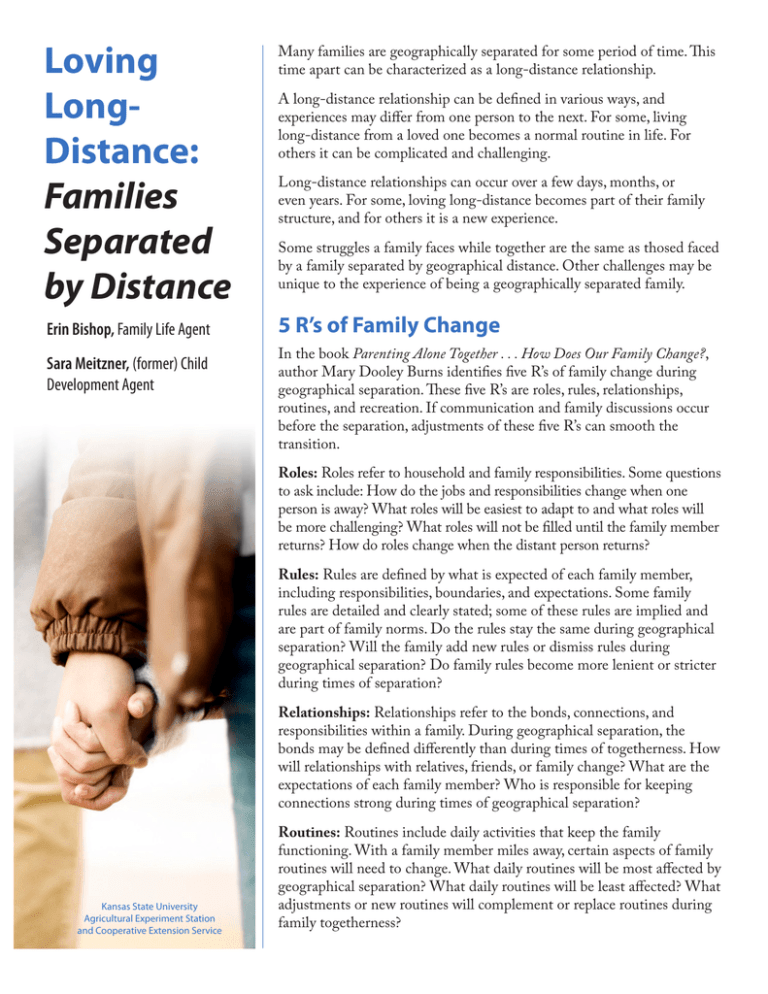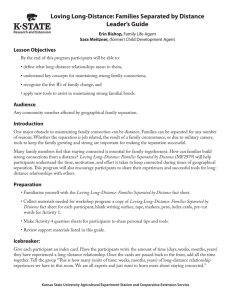
Loving
LongDistance:
Families
Separated
by Distance
Erin Bishop, Family Life Agent
Sara Meitzner, (former) Child
Development Agent
Many families are geographically separated for some period of time. This
time apart can be characterized as a long-distance relationship.
A long-distance relationship can be defined in various ways, and
experiences may differ from one person to the next. For some, living
long-distance from a loved one becomes a normal routine in life. For
others it can be complicated and challenging.
Long-distance relationships can occur over a few days, months, or
even years. For some, loving long-distance becomes part of their family
structure, and for others it is a new experience.
Some struggles a family faces while together are the same as thosed faced
by a family separated by geographical distance. Other challenges may be
unique to the experience of being a geographically separated family.
5 R’s of Family Change
In the book Parenting Alone Together . . . How Does Our Family Change?,
author Mary Dooley Burns identifies five R’s of family change during
geographical separation. These five R’s are roles, rules, relationships,
routines, and recreation. If communication and family discussions occur
before the separation, adjustments of these five R’s can smooth the
transition.
Roles: Roles refer to household and family responsibilities. Some questions
to ask include: How do the jobs and responsibilities change when one
person is away? What roles will be easiest to adapt to and what roles will
be more challenging? What roles will not be filled until the family member
returns? How do roles change when the distant person returns?
Rules: Rules are defined by what is expected of each family member,
including responsibilities, boundaries, and expectations. Some family
rules are detailed and clearly stated; some of these rules are implied and
are part of family norms. Do the rules stay the same during geographical
separation? Will the family add new rules or dismiss rules during
geographical separation? Do family rules become more lenient or stricter
during times of separation?
Relationships: Relationships refer to the bonds, connections, and
responsibilities within a family. During geographical separation, the
bonds may be defined differently than during times of togetherness. How
will relationships with relatives, friends, or family change? What are the
expectations of each family member? Who is responsible for keeping
connections strong during times of geographical separation?
Kansas State University
Agricultural Experiment Station
and Cooperative Extension Service
Routines: Routines include daily activities that keep the family
functioning. With a family member miles away, certain aspects of family
routines will need to change. What daily routines will be most affected by
geographical separation? What daily routines will be least affected? What
adjustments or new routines will complement or replace routines during
family togetherness?
The Five R’s
Roles
Rules
Relationships
Routines
Recreation
Recreation: Recreation, special events, and celebrations will also be
affected when family members are separated by physical distance.
Mapping out a plan for these special family events is also important
to keep connected with those who are apart. Does the family continue
to celebrate events during separation? How will the distant family
member be included in celebrations or special events? Are special events
postponed until the distant family member returns?
Some of these R’s may be more affected than others, but preparation is
best. Deciding how to make changes that are helpful to all family members
involved can help ease the transition between “together” and “apart.”
Tips for Staying Connected
Research at North Dakota State University (2002) identified five distinct
areas for maintaining connections during separation. These tips may help
families stay connected.
1. Establish regular routines for staying connected: Strong relationships
are built on trust and security. People thrive in environments when
they have routines and traditions they can depend on.
• Plan how you will most likely communicate.
• Set aside a specific day or time to make contact. This can include
phone calls, internet chats, emails, text messages, or old-fashioned
letters.
2. Take the initiative: Take the first step in contacting a loved one. These
things can be very simple.
• Be the first to make contact.
• Take pictures of special events the distant family member may have
missed.
3. Brainstorm creative activities together: There are many different ways
to be “together” even when you are apart. Talking with others in
similar situations can give you fresh ideas for maintaining your family
relationships.
• Read the same book or watch the same movie and spend time
discussing it. Have the distant family member record stories, songs,
or special messages for each family member before leaving.
4. Work on maintaining relationship satisfaction. While distance can be
a struggle, each member can feel nurtured and satisfied during times of
geographical separation.
• Listen! Pay attention to what each family member is saying.
• Make a consistent effort to keep connection routines, even when life
gets busy.
2
5. Take advantage of technology: Family members can feel included
if you make a special effort to connect with them using some of the
methods now available.
• Daily activities can include: calling, emailing, texting, video-chat, or
letter writing.
• Families can make videos to send to distant members. Distant
members can make videos of daily life to share with family members
back home.
Other ideas can be found at http://www.fambooks.com. The site includes
suggestions and creative ideas for staying connected for moms, dads, and
couples experiencing geographical separation.
Loving Long-Distance
Family distance can be stressful and challenging, but it also provides
unique ways for strengthening family ties. Defining what geographical
separation means for your family is the first step. Start with the five R’s
of family separation and change by brainstorming ways in which family
roles, rules, relationships, routines, and recreation can be adjusted to make
the separation less difficult. Spending time being creative in maintaining
family connections may help all family members feel included and valued
during this time of transition.
References
Brotherson, S. (2002). Making the connection: Building long-distance
relationships; Member’s Guide, Handouts #1, #2, #3, and Overhead #1.
North Dakota State Extension Services.
http://www.ag.ndsu.edu/family/family-community-education/
making-the-connection
Burns, Mary Dooley. (1994). Parenting Alone Together ... How Does
Our Family Change? The 5 R’s. Minneapolis, MN: Family Information
Services.
Hill, M. J. (1996). Keeping in touch: When distance keeps you apart; Fact
Sheet. Ohio State University Extension.
Hill, M.J. (1997) Welcome Back! Here’s what’s been happening while you
were gone; Fact Sheet. Ohio State University Extension.
Military OneSource. (no date) Double Duty: Staying connected with your kids
when you’re a deployed dad. (CD) http://www.militaryonesource.com/MOS/
FindInformation/Category/Topic/Issue/Material.aspx?MaterialID=16611&
MaterialTypeID=0; (800) 342-9647
The National Institute for Building Long Distance Relationships (2001).
Dads at a distance: An activities handbook for strengthening long distance
relationships. A&E Family Publishers, Provo, Utah.
3
Uniformed Services University of Health Sciences (2004). Becoming a
couple again: How to create a shared sense of purpose after deployment.
www.usuhs.mil; Bethesda, MD.
Reviewers
Charlotte Shoup Olsen, Ph.D., Specialist, Family and Marital
Relationships, K-State Research and Extension and Professor, Kansas
State University Family Studies and Human Services.
Anna Mae Brown, Family and Consumer Sciences Agent, K-State
Research and Extension – Crawford County
Rebecca McFarland, Family and Consumer Sciences Agent, K-State
Research and Extension – Frontier District
Brand names appearing in this publication are for product identification purposes only. No endorsement is
intended,
nor is criticism implied of similar products not mentioned.
Publications from Kansas State University are available at: www.ksre.ksu.edu
Publications are reviewed or revised annually by appropriate faculty to reflect current research and practice.
Date shown is that of publication or last revision. Contents of this publication may be freely reproduced
for educational purposes. All other rights reserved. In each case, credit Erin Bishop, et al, Loving Long
Distance: Families Separated by Distance, Fact Sheet, Kansas State University, July 2011.
Kansas State University Agricultural Experiment Station and Cooperative Extension Service
MF2979
July 2011
K-State Research and Extension is an equal opportunity provider and employer. Issued in furtherance of Cooperative Extension Work, Acts of May 8 and June 30, 1914,
as amended. Kansas State University, County Extension Councils, Extension Districts, and United States Department of Agriculture Cooperating, Gary Pierzynski, Interim
Director.
4







